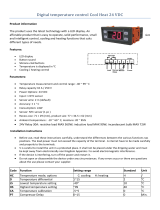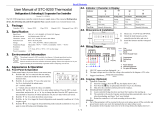
EKC 202D1 Manual RS8FL402 © Danfoss 2015-12 13
If the controller is built into a network with data communication, it must have an
address, and the master gateway of the data communication must then know this
address.
These settings can only be made when a data communication module has been
mounted in the controller and the installation of the data communication cable has
been nished.
This installation is mentioned in a separate document “RC8AC”.
After installation of a data communi-
cation module the controller can be
operated on an equal footing with the
other controllers in ADAP-KOOL®
refrigeration controls.
The address is set between 1 and 240 , gateway determined o03
The address is sent to the gateway when the menu is set in pos. ON
IMPORTANT: Before you set o04, you MUST set o61. Otherwise you will be transmit-
ting incorrect data.
o04
Access code 1 (Access to all settings)
If the settings in the controller are to be protected with an access code you can set a
numerical value between 0 and 100. If not, you can cancel the function with setting 0.
(99 will always give you access).
o05 -
Sensor type
Normally a Pt 1000 sensor with great signal accuracy is used. But you can also use a
sensor with another signal accuracy. That may either be a PTC sensor (1000 ohm at
25°C) or an NTC sensor (5000 Ohm at 25°C).
All the mounted sensors must be of the same type.
o06 SensorCong
Pt = 0
PTC = 1
NTC = 2
Display step
Yes: Gives steps of 0.5°
No: Gives steps of 0.1°
o15 Disp. Step = 0.5
Max. standby time after coordinated defrost
When a controller has completed a defrost it will wait for a signal which tells that the
refrigeration may be resumed. If this signal fails to appear for one reason or another,
the controller will itself start the refrigeration when this standby time has elapsed.
o16 Max HoldTime
Select signal for the display S4%
Here you dene the signal to be shown by the display.
S3, S4, or a combination of the two.
With setting 0% only S3 is used. With 100% only S4.
o17 Disp. S4%
Digital input signal - D2
The controller has a digital input 2 which can be used for one of the following func-
tions:
O: The input is not used.
1) Status display of a contact function
2) Door function. When the input is open it signals that the door is open. The refrig-
eration and the fans are stopped. When the time setting in “A4” is passed, an alarm
will be given and refrigeration resumed.
3) Door alarm. When the input is open it signals that the door is open. When the time
setting in “A4” is passed an alarm will be given.
4) Defrost. The function is started with a pulse signal. The controller will register when
the DI input is activated. The controller will then start a defrost cycle. If the signal
is to be received by several controllers it is important that ALL connections are
mounted the same way (DI to DI and GND to GND).
5) Main switch. Regulation is carried out when the input is short-circuited, and regula-
tion is stopped when the input is put in pos. OFF.
6) Night operation. When the input is short-circuited, there will be regulation for
night operation.
7) Reference displacement when DI2 is short-circuited. Displacement with “r40”.
8) Separate alarm function. Alarm will be given when the input is short-circuited.
9) Separate alarm function. Alarm will be given when the input is opened.
10) Case cleaning. The function is started with a pulse signal. Cf. also description on
page 4.
11) Forced refrigeration when the input is short-circuited.
12) The input is used for coordinated defrost in conjunction with other controllers of
the same type
o37 DI2 cong.
Conguration of light function (relay 4 in applications 2)
1) The relay cuts in during day operation
2) The relay to be controlled via data communication
3) The relay to be controlled by the door switch dened in either o02 or o37 where
the setting is selected to either 2 or 3. When the door is opened the relay will cut in.
When the door is closed again there will be a time delay of two minutes before the
light is switched o.
o38 Light cong
Activation of light relay
The light relay can be activated here, but only if dened in o38 with setting 2.
o39 Light remote
Rail heat during day operation
The ON period is set as a percentage of the time
o41 Railh.ON day%
Rail heat during night operation
The ON period is set as a percentage of the time
o42 Railh.ON ngt%
Rail heat cycle
The period of time for the aggregate ON time + OFF time is set in minutes
o43 Railh. cycle






















